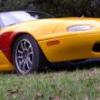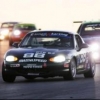A bit surprised with the 1.6 but I don’t have any quantitative info the the the G-locs to judge just how much difference there is between 12 & 10. Don’t they publish that stuff?
Even more surprised by the NB combo despite having less experience on that platform. Danny, is that closer to what you run?
Stopping is essentially just straight-line cornering, the G’s/acceleration is just longitudinal rather than lateral. That IS the point of the classic friction circle after all. We’ll never see a circle because our engines make no power, but for cornering, braking and any combination of those the idea is the same, get all four contact patches operating very close to their limits of adhesion while maintaining control. If you rely more than necessary on the fronts then you are leaving something on the table, PERIOD, I don’t really care how you drive. Someone offer evidence, or even a good rational explanation why that’s wrong. I’m listening. There's a lot to be said for modulation and trail-braking friendly compounds but those fall under “while maintaining control†and don’t change the fundamentals.
It’s also worth noting that the flatter your car stops (meaning less nose-dive) the less, and less abrupt, the weight transfer off the fronts returning to the rear as you get off the brakes, making the transition approaching and entering corners smoother. Again, the friction circle, and keeping the work split as evenly as possible between all four tires as much as possible. It starts with physics and trying to outsmart it is almost always a losing battle. TO BE CLEAR, I’m not saying that any of the above mentioned combinations don’t accomplish that with a given setup on a given car, but I am saying that any comments about the rears not mattering much are wrong, and with a few extreme exceptions there is no need to vary that balance by track.
Hmm....I'm trying to understand the suspension dynamics you are postulating. As far as I understand, final weight transfer (not rate of transfer, but ultimate "static loading") is a function of CG-height, spring-rate, and force (cornering or stopping). Dive (or squat) can be controlled to a degree with anti-dive(or squat) suspension geometry, but we don't have that. So, I don't see how changing the brake bias to more aft causes less dive, without resulting in less total braking force. Dragging a car down from the rear-axel doesn't change the weight transfer/dive characteristics.
For sure, if the rear tires have more grip to give at their given downforce...then more rear-bias makes sense. But, that increase in total braking force should result in MORE dive, not less.




 Sign In
Sign In Create Account
Create Account









 Back to top
Back to top Report
Report

















